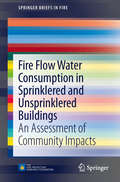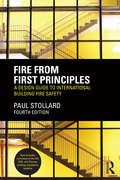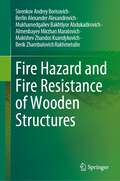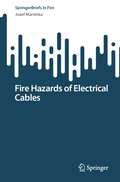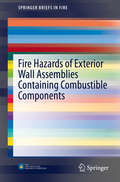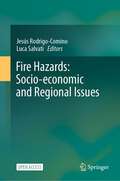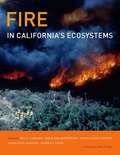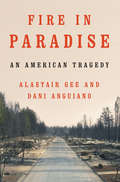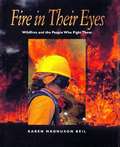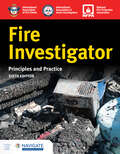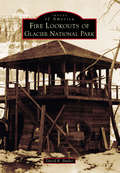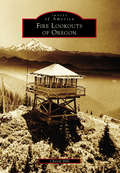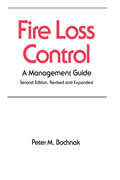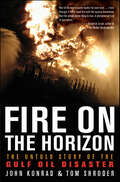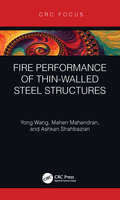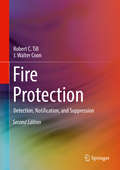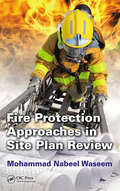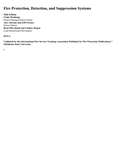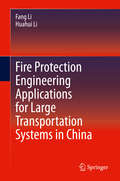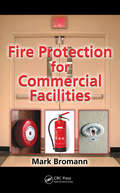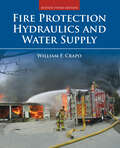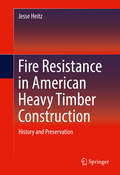- Table View
- List View
Fire Fighter! (Eyewitness Readers level #2)
by Angela RoystonDescribes a day in the life of a group of fire fighters
Fire Flow Water Consumption in Sprinklered and Unsprinklered Buildings: An Assessment of Community Impacts
by Inc. Code ConsultantsFire Flow Water Consumption in Sprinklered and Unsprinklered Buildings offers a detailed analysis for calculating the fire water demand required in buildings with existing and non-existant sprinkler systems. The installation of automatic sprinkler systems can significantly reduce the amount of water needed during a fire, but it requires water for commissioning, inspection, testing, and maintenance (CITM). This book provides an estimate of fire water used under both fire conditions, including CITM, to allow communities to develop fire water fees for both sprinklered and unsprinklered buildings that are proportional to the anticipated fire water usage. The types of buildings analyzed include residential (family dwellings as well as those up to four stories in height), business, assembly, institutional, mercantile, and storage facilities. Water volume was studied using guidelines from the International Code Council, the National Fire Protection Association, and the Insurance Services Office. Fire Flow Water Consumption in Sprinklered and Unsprinklered Buildings is intended for practitioners as a tool for analyzing water consumption in fire situations and for providing them with key information on the best types of water systems in a variety of buildings. Researchers working in building planning and safety will also find the book valuable.
Fire from First Principles: A Design Guide to International Building Fire Safety
by Paul StollardFire safety is a fundamental requirement of any building, and is of concern to several professions which contribute to the construction process. Following on from the success of the previous three editions, Paul Stollard has returned to update and expand this classic introduction to the theoretical basis of fire-safety engineering and risk assessment. Avoiding complex calculations and specifications, Fire From First Principles is written with architects, building control officers and other construction professionals without fire engineering backgrounds in mind. By tackling an overview of the factors which contribute to fire risk, and how building design can limit these, the reader will gain a fuller understanding of the science behind fire regulations, safe design, and construction solutions. All regulations content is fully updated, and has been expanded to cover the USA and China as well as the UK. Ideal for students of architecture and construction subjects, as well as practitioners from all built environment fields learning about fire safety for the first time.
Fire Hazard and Fire Resistance of Wooden Structures
by Sivenkov Andrey Borisovich Berlin Alexander Alexandrovich Mukhamedgaliev Bakhtiyor Abdukadirovich Almenbayev Mirzhan Maratovich Makishev Zhandos Kuandykovich Berik Zhambulovich RakhmetulinThis monograph discusses fire hazard and fire resistance in wooden structures with a long duration of operation. Aside from its increasing importance for modern architecture, wood has been the most important building material in the past. It has a distinct aesthetic, high mechanical strength, and resistance against many environmental changes. These properties are evident in structures like the still standing Grinstead Chuch, which has been built in 1045. Readers will however learn about the decreasing fire resistance in wooden buildings with a long service live. Considering the cultural value of medieval wood buildings, this topic becomes increasingly relevant. The chapters discuss the mechanical, physico-chemical and thermophysical properties of wooden structures over different lifespans. Many factors contributing to the changing fire resistance in the ageing process of wooden structures, are explained. This book is a valuable resource for students, teachers and scientists in the areas of wood science, fire research and forestry.
Fire Hazards of Electrical Cables (SpringerBriefs in Fire)
by Jozef MartinkaThis book offers a comprehensive approach to the assessment of fire hazards of electrical cables. The first part of the book describes division of cables, main parameters of electrical cables, and fault scenarios of cables leading to fire or occupant injuries. The traditional approach to fire hazards of electrical cables assessment is also described in the first part. The second part of the book is focused on the creation and description of a new approach to fire hazard assessment of electrical cables. The new approach is based on the assessment of both ignition parameters of electrical cables and the impact of their fires on the surrounding area. The ignition parameters include critical heat flux, ignition temperature, and critical electrical current. The impact of cable fires on the surrounding area is expressed by the released heat, toxicity of combustion products (determined by the amount of released carbon oxides and oxygen consumed), and visibility (determined by the smoke extinction area). Newly created approach is practically illustrated on specific types of cables (power cables classified to B2ca and Fca reaction to fire class) in this book. The book is intended mainly for academics in the fields of both fire protection engineering and electrical engineering. Besides that, the professionals in fire safety will find valuable information concerning impact of electrical cables on the safety of occupants and structures during fire in the book. In addition, the book sheds light on the issue of fire safety of electrical cables for the professionals in both electrical and power engineering. Last but not least, the book is appropriate also for students in the fields of fire, electrical, and power engineering in bachelor, master, and Ph.D. degree.
Fire Hazards of Exterior Wall Assemblies Containing Combustible Components
by Nathan White Michael DelichatsiosThis SpringerBrief presents strategies for fire mitigation based on combustible assembly systems of exterior walls. Providing background information on common exterior wall systems, the mechanisms of fire spread, and case studies, it examines the difficulties in controlling a fire with several materials and assembly methods. The brief compiles information on typical fire scenarios which involve the exterior wall, along with further exploration into test methods, approval and regulatory requirements for the various assembly systems. Offering testing approaches for possible mitigation strategies, the brief takes into account that current commercial wall assembly systems are constructed to improve energy performance, reduce water and air infiltration, and allow for aesthetic design flexibility. Exterior Insulation Finish Systems, metal composite claddings, high-pressure laminates, and weather-resistive barrier systems all have components which directly impact the fire hazard. Recommendations for future exterior wall construction are based on identified knowledge gaps.
Fire Hazards: Socio-economic and Regional Issues
by Jesús Rodrigo-Comino Luca SalvatiThe open access book aims to show the readers novel, relevant and reproducible power of synergistic collaborations between European research groups and stakeholders with the objective to synthesize the existing knowledge and expertise about fire management and hazard and defining a concerted research agenda that promotes an integrated approach to create fire-resilient landscapes, taking into account biological, biochemical and physical, but also socio-economic, historical, geographical, sociological, perception and policy constraints. This is an urgent societal need due to the expected further intensification and geographical spreading of wildfire regimes under Global Change. Fire has been part of the Earth's System for the last 400 million years, and humans are the sole species that controls and manages fire. We have used fire for over a million years, both, as hunter-gatherers managing the landscape with fire and as farmers using fire as a low-cost, efficient and ecological tool for clearing and maintaining the productivity of the land. Fire has been highlighted as the most influential element in the development of human societies. The increase in prolonged dry and hot periods observed in many regions of the world is exacerbating the risk of fire. The causes of increased fire risk are not only linked to climate change but are also a consequence of economic and social changes and political decisions. Over the past few decades, many countries’ rural areas have seen significant depopulation and a reduction in land management as residents moved to cities or even other countries in search of work. The resulting rural depopulation has led to revegetation of the abandoned agricultural land, which favors fire spread. The enhanced risk of fires is moving beyond the capacity of even the best-funded wildland firefighting teams and therefore calls for the development of new approaches to fire management that are key nowadays at different scales. Instead of focusing primarily on increasing firefighting capabilities, a more effective approach is needed that focuses on long-term fire prevention through vegetation management by reducing fuel load or managing fuel type and fuel continuity at a landscape level. FIRElinks (COST Action CA18135) is developing the EU-spanning network of scientists and practitioners involved in forest fire research and land management with backgrounds such as fire dynamics, fire risk management, fire effects on vegetation, fauna, soil and water and socio-economic, historical, geographical, political perception and land management approaches. Among the different Working Groups, number 5 is aimed to connect communities from different scientific and geographic backgrounds, allowing the discussion of different experiences and the emergence of new approaches to fire research, human management, regional issues and socio-economic aspects.
Fire in California's Ecosystems
by Neil G. Sugihara Kevin E. Shaffer Andrea E. Thode Jan W. Van WagtendonkFire is both an integral natural process in the California landscape and growing threat to its urban and suburban developments as they encroach on wildlands. Written by many of the foremost authorities on the subject, this comprehensive volume, an ideal text and authoritative reference tool, is the first to synthesize our knowledge of the science, ecology, and management of fire in California. Part I introduces the basics of fire ecology. It includes an historical overview of fire, vegetation, and climate in California; overviews of fire as a physical and ecological process; and reviews the interactions between fire and the physical, plant, and animal components of the environment. Part II explores the history and ecology of fire in each of California's nine bioregions. Part III examines fire management in California, including both Native American and post-European settlement; discusses current issues related to fire policy and management, including air quality, watershed management, invasive plant species, native species, and fuel management; and considers the future of fire management.
Fire in Paradise: An American Tragedy
by Alastair Gee Dani AnguianoThe harrowing story of the most destructive American wildfire in a century. There is no precedent in postwar American history for the destruction of the town of Paradise, California. On November 8, 2018, the community of 27,000 people was swallowed by the ferocious Camp Fire, which razed virtually every home and killed at least 85 people. The catastrophe seared the American imagination, taking the front page of every major national newspaper and top billing on the news networks. It displaced tens of thousands of people, yielding a refugee crisis that continues to unfold. Fire in Paradise is a dramatic and moving narrative of the disaster based on hundreds of in-depth interviews with residents, firefighters and police, and scientific experts. Alastair Gee and Dani Anguiano are California-based journalists who have reported on Paradise since the day the fire began. Together they reveal the heroics of the first responders, the miraculous escapes of those who got out of Paradise, and the horrors experienced by those who were trapped. Their accounts are intimate and unforgettable, including the local who left her home on foot as fire approached while her 82-year-old father stayed to battle it; the firefighter who drove into the heart of the inferno in his bulldozer; the police officer who switched on his body camera to record what he thought would be his final moments as the flames closed in; and the mother who, less than 12 hours after giving birth in the local hospital, thought she would die in the chaotic evacuation with her baby in her lap. Gee and Anguiano also explain the science of wildfires, write powerfully about the role of the power company PG&E in the blaze, and describe the poignant efforts to raise Paradise from the ruins. This is the story of a town at the forefront of a devastating global shift—of a remarkable landscape sucked ever drier of moisture and becoming inhospitable even to trees, now dying in their tens of millions and turning to kindling. It is also the story of a lost community, one that epitomized a provincial, affordable kind of Californian existence that is increasingly unattainable. It is, finally, a story of a new kind of fire behavior that firefighters have never witnessed before and barely know how to handle. What happened in Paradise was unprecedented in America. Yet according to climate scientists and fire experts, it will surely happen again.
Fire in Their Eyes: Wildfires and the People Who Fight Them
by Karen Magnuson BeilDepicts the training, equipment, and real-life experiences of people who risk their lives to battle wildfires, as well as people who use fire for ecological reasons.
Fire Inspection and Code Enforcement
by Lynne MurnaneMake sure that you have the training and certification needed to provide the best risk reduction to your community. Reducing community risk requires trained individuals to verify that a locality adheres to locally adopted fire and life-safety standards for structural safety components in construction and renovations. <p><p>Fire Inspection and Code Enforcement, 8th Edition, provides fire and emergency services personnel and civilian inspectors with the basic information necessary to meet the job performance requirements (JPRs) of NFPA 1031 for Level I and Level II Fire Inspectors. Chapters are delineated with two clearly marked sections: the first section for Level I information followed by a second section for Level II information.
Fire Investigator: Principles and Practice
by International Association of Arson InvestigatorsThe National Fire Protection Association (NFPA) and the International Association of Arson Investigators (IAAI) are pleased to bring you Fire Investigator: Principles and Practice, Sixth Edition, the next evolution in fire investigator training. Covering the entire spectrum of the 2020 Edition of NFPA 921: Guide for Fire and Explosion Investigation and 2021 Edition of NFPA 1033: Standard for Professional Qualifications for Fire Investigator, the Sixth Edition offers a comprehensive introduction to the knowledge and skills needed to be an effective fire investigator. The textbook opens with details on how to use available investigation resources and the basics of fire science and investigation methodology, then evolves to discuss processes and special considerations for investigating specific types of fires and explosions. This progression helps readers understand complex intricate subject matter as theyand advance from basic technical knowledge to high-level analysis and be able to understand and understanding of complex fire events. Fire Investigator: Principles and Practice, Sixth Edition enhancements: Re-organized and consolidated content now delivered in only 18 chapters to better align to common course lengths Updated and expanded coverage of critical topics like fire investigator ethics, scene safety, legal issues, and scientific method analysis New cNew coverage of topics includinglike conducting research onlineonline research, controlled demolition approaches, use of canines, documentation ofing wildland fires, and more New cases, exercises, and thought-provoking questions to stimulate critical thinking
Fire Lookouts of Glacier National Park
by David R. ButlerThe first fire lookouts in the Glacier National Park region were simply high points atop mountain peaks with unimpeded views of the surrounding terrain. Widespread fires in the 1910s and 1920s led to the construction of more permanent lookouts, first as wooden pole structures and subsequently as a variety of one- and two-story cabin designs. Cooperating lookouts in Glacier Park, the Flathead National Forest, and the Blackfeet Indian Reservation provided coverage of forests throughout Glacier National Park. Beginning in the 1950s, many of the lookouts were decommissioned and eventually destroyed. This volume tells the story of the rise and fall of the extensive fire lookout network that protected Glacier National Park during times of high fire danger, including lookouts still operating today.
Fire Lookouts of Oregon (Images of America)
by Cheryl HillThe first lookouts were rustic camps on mountaintops, where men and women were stationed to keep an eye out for wildfires. As the importance of fire prevention grew, a lookout construction boom resulted in hundreds of cabins and towers being built on Oregon's high points. When aircraft and cameras became more cost-effective and efficient methods of fire detection, many old lookouts were abandoned or removed. Of the many hundreds of lookouts built in Oregon over the past 100 years, less than 175 remain, and only about half of these are still manned. However, some lookouts are being repurposed as rental cabins, and volunteers are constantly working to save endangered lookouts. This book tells the story of Oregon's fire lookouts, from their heyday to their decline, and of the effort to save the ones that are left.
Fire Loss Control: A Management Guide, Second Edition,
by P. M. BochnakProvides managers, architects, plant engineers, technicians, and others with a concise background in the principles of fire protection and property loss control (a new chapter on life safety elements was added to the second edition). Some of the topics are the characteristics and behavior of fire, t
Fire on the Horizon: The Untold Story of the Gulf Oil Disaster
by John Konrad Tom Shroder"A phenomenal feat of journalism. . . . I tore through it like a novel but with the queasy knowledge that the whole damn thing is true." —Sebastian Junger, author of The Perfect Storm and WarBlending exclusive first-person interviews and penetrating investigative reporting, oil rig captain John Konrad and veteran Washington Post writer Tom Shroder give the definitive, white-knuckled account of the Deepwater Horizon explosion—as well as a riveting insider’s view of the byzantine culture of offshore drilling that made the disaster inevitable. As the world continues to cope with the oil spill’s grim aftermath—with environmental and economic consequences all the more dire in a region still rebuilding from Hurricane Katrina—Konrad and Schroder’s real-time account of the disaster shows us just where things went wrong, and points the way to a safer future for us all.
Fire Performance of Thin-Walled Steel Structures
by Yong Wang Mahen Mahendran Ashkan ShahbazianThis book is an authoritative account of the latest developments in fire performance and fire resistant design of thin-walled steel structures. It provides a comprehensive review of recent research, including fire tests of thin-walled steel structural members and systems, numerical modelling of heat transfer and structural behaviour, elevated temperature material properties, methods of improving fire resistance of thin-walled steel structures, and performance based fire resistant design methods. Worked examples navigate the reader through some of the complexities of this specialist subject. This is the first book devoted to the fundamental principles of this emerging subject, as thin-walled steel structures are increasingly being used in building construction. It will be valuable to fire protection engineers who want to optimise fire resistant design of thin-walled steel structures, and specialist manufacturers needing to control fire resistance of thin-walled steel structural systems, as well as to the research community.
Fire Phone: A get-started-now guide to Firefly, Mayday, Dynamic Perspective, and other new features
by Brian SawyerDive straight into hot Fire phone features you won’t find in any other device—like Firefly, Mayday, and Dynamic Perspective—with this concise hands-on guide. You probably already know how to make calls, text, and take photos with Amazon’s new phone, but where it really shines is in innovative features you’ve never even seen before. This intuitive, easy-to-follow book opens a world of possibilities with the Fire phone, right out of the box.Instantly identify and order just about any product with Firefly—from DVDs, CDs, and books (or their electronic equivalents) to nearly anything else with a barcodeUse Mayday to get live, hands-on tech support and customer service right on your phoneImmerse yourself in 3D games, maps, and apps with the Dynamic Perspective sensor systemNavigate easily with new one-handed (and no-handed!) gestures found only on Fire phone
Fire Protection: Detection, Notification, and Suppression
by Robert C. Till J. Walter CoonThe Second Edition of this introduction to fire protection systems is completely revised and updated to offer the student, architect or engineer the basics of fire protection devices and equipment, and how they may be applied to any given project. Fire Protection: Detection, Notification, and Suppression reveals the “nuts and bolts” of fire protection system selection, design and equipment in an applied approach. Whether a mechanical engineer, safety engineer, architect, estimator, fire service personnel, or student studying in these areas, the authors show the pros and the cons of protection systems being proposed, and how they should be compared to one another. It also gives non-fire engineering practitioners a sense of proportion when they are put in a position to select a consultant, and to give a sense of what the consultant may be doing and how a system is being matched to the hazard. Beginning fire protection engineers could also use its language for writing a report about these systems for a client.
Fire Protection Approaches in Site Plan Review
by Mohammad Nabeel WaseemThis book provides the fundamental concepts of fire protection as they relate to site planning. It educates readers whether they are architects, engineers, developers, fire fighters, fire inspectors, or code officials, and explains the importance of proper site plan review. Poor design and overlooked details often lead to delayed response time, resulting in loss of life and property. Topics covered include the importance of grading, fire codes, fire flow, fire truck access, fire department connections, aerial ladder truck access, fire lines and more.
Fire Protection, Detection, And Suppression Systems
by Cynthia Brakhage Alex Abrams Jeff Fortney International Fire Service Training Association StaffThe purpose of this new text is to familiarize the fire service and others with the components, design, maintenance, operation, testing, and inspection of common fire protection, detection, and suppression systems. This new edition reflects the most current equipment, technology, and practices. This new edition (previously titled Fire Detection and Suppression Systems, Fourth Edition) is a resource for emergency services personnel who respond to incidents in protected premises. This manual is also a valuable resource for fire inspectors and for people who design, maintain, and inspect fire protection systems. What is an automatic fire sprinkler system and how does it operate? Is a heat detector different than a smoke detector? Is that stand pipe installed properly? Is the hood system in this café charged with the right dry chemical? When the fire alarm system alerts people in the building to a fire does the system automatically call the fire department? Is a high rise building required to have a smoke control system? What type of fire pump is in this building? This new text is a resource to learn about these and other fire detection and suppression systems. Systems like these provide fire protection, detection, and suppression. They are installed in buildings that house many different occupancies that impact the design and operation of the systems. These systems are designed to detect the presence of fire, alert occupants and emergency responders to the condition, and to suppress or extinguish the fire. Components of these systems are constantly changing and improving with advances in technology. This textbook is designed to meet the course objectives, outcomes, and outline for the associate’s level core curriculum course, Fire Protection Systems, as established by the Fire and Emergency Services Higher Education (FESHE) initiative of the United States Fire Administration (USFA).
Fire Protection Engineering Applications for Large Transportation Systems in China
by Fang Li Huahui LiThe rapid development of China’s transportation system brings huge challenges to fire safety issues. Fire Protection Engineering Applications for Large Transportation Systems in Chinaanalyzes key fire issues for large transportation systems in rail, airport, tunnels, etc. and offers solutions and best practices for similar projects throughout the world. The first monograph to look at transportation hub fire issues in China looks at architecture features, occupancy and area classification, fire hazard and design difficulties based on local code design. The book then provides case studies to identity the common problems and introduces possible solutions in order to develop a best practice for future design and improvement.The authors worked directly on the case studies provided, which include the Hongqiao airport transportation hub, Beijing and Pudoing airport PBD study, subways in different cities and the high speed train system Cross China. They use their research and investigation to form the theoretical basis for the fire design of urban large transportation hubs and the establishment of corresponding fire codes.The cutting-edge technologies discussed include:Smoke control strategy in complicated multiple function space, assistant evacuationperformance based studynew technology on fire separationnew fire products for smoke detection and intelligent guiding system for evacuationBIM and internet of things used to improve fire management
Fire Protection for Commercial Facilities
by Mark BromannWhen confronted with a fire protection problem, building management is often desperately short on information and know-how in this critical component of protection for their own facility. It is not that the material is hard to grasp, but that there is so much of it that makes the task seem so daunting. Touching on the many subfields of fire protect
Fire Protection Hydraulics and Water Supply, Revised Third Edition
by William F. CrapoFire service pump operators must have an understanding of the many laws of science that govern the study of hydraulics and water supply in order to be able to handle the complex hydraulic problems that may arise in real world scenarios.
Fire Resistance in American Heavy Timber Construction
by Jesse HeitzThis volume presents ahistory of heavy timber construction (HTC) in the United States, chroniclingnearly two centuries of building history, from inception to a detailed evaluationof one of the best surviving examples of the type, with an emphasis on fireresistance. The book does not limit itself in scope to serving only as a commonhistory. Rather, it provides critical analysis of HTC in terms of constructionmethods, design, technical specifications, and historical performance underfire conditions. As such, this book provides readers with a truly comprehensiveunderstanding and exploration of heavy timber construction in the United Statesand its performance under fire conditions.

